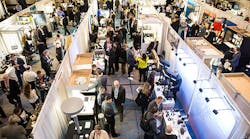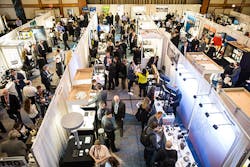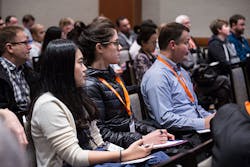Held March 29-30, 2016, at the N.Y. Hilton at Midtown hotel, LEDucation 10, hosted by the Designers Lighting Forum of New York (DLFNY), with the support of the Illuminating Engineering Society (IESNA), attracted 4,200+ lighting professionals. In the exhibit area, more than 250 manufacturers and distributors displayed their products and services. Additionally, over 30 accredited educational seminars covered the basics of LED lighting, healthcare, controls, codes and compliance, flicker and more.
These four conference session summaries offer an overview of what’s currently happening in the world of lighting design and operation.
In “When LEDs Are Acting Up Rather than Dimming”, Randy Thomas, WattStopper, San Jose, Calif., explained that an LED is a current-driven device, with a light output directly proportional to its forward current, and that there is an important relationship among the driver, the control system and the supply voltage when a circuit is dimmed. To understand how dimming will affect a luminaire’s performance, it’s important to be able to read a luminaire testing report.
In some cases, unacceptable flicker occurs when the minimum load requirement of the dimmer is not met, meaning that the switching device (triac or SCR) does not consistently conduct. Flicker can be eliminated by specifying the minimum number of luminaires per circuit load, and by understanding power profiles of the LED device. A second important consideration is to define that degree of flicker that is acceptable on a project. As a general rule, multiple light sources should not be mixed on a single dimmer output.
Related
Two other considerations are smoothness and dimming linearity. Smoothness is a rating of the luminaire’s reaction to a long (20 sec.) fade from full on to full off. Any noticeable jumps, flickering or flashing reduces the smoothness rating. Perfect dimming linearity means that each 10% interval in the range produces an equal dimming step (one-tenth of the brightness at full on).
“Bringing Intelligence to Outdoor Lighting,” presented by Rita Renner, Echelon Corp., San Jose, Calif., discussed how energy savings of 20% to 30% can be gained by adding a control circuit to an exterior LED lighting system. The benefits include automated asset monitoring and reducing the payback period by 25% to 80% beyond just relamping. Other benefits include: fixed time of day dimming, astronomical clock and event-based dimming, compensation for light loss over time, extension of useful lamp life, the ability to anticipate lamp failure, and timely outage notification.
Installation of the control network can rely on either a wired or wireless connection for backhaul — connecting each streetlight node to a control center for data analysis and action. Two benefits of a wireless mesh network are self-healing, meaning that the network continues to operate when a node fails, and self-forming, which means that when a node powers up, it automatically seeks to communicate with other nodes and establish a link to a gateway. Additionally, a combination of both wired and wireless, called hybrid, can be used.
Benefiting from a control scheme, the light output of a roadway luminaire can be changed from sunset to midnight and midnight to dawn, or at other intervals in between. During inclement weather, such as fog or rain, the light output can be adjusted for maximum safety, and similar scenario is possible during an accident/emergency or police activity.
In “Lighting Systems that Think”, Richard J. Radke, Rensselaer Polytechnic Institute (RPI), Troy, N.Y., described his involvement with the Lighting Enabled Systems & Applications Engineering Research Center (LESA ERC). LESA’s task is to figure out what lighting systems will be like in the future, which includes studying how luminaires will change color, brightness, and directionally in response to a number of inputs, such as sensors, cellphones, and other devices, all networked with the Internet of Things (IoT). Every IoT company is interested in knowing about electrical lighting systems, because they are ubiquitous throughout a building, or facility, and they can form the backbone of a high-speed sensing and reporting network.
The LESA facility at RPI is assisted by other research partners: Boston University, focusing on visual light communications; the University of New Mexico, which is working on advanced sensor technology; and Thomas Jefferson University, where light and circadian effects are studied in detail.
Support also comes from LESA’s industrial advisory board, which includes: Philips; OSRAM Sylvania; Current, powered by GE; Acuity Brands; Crestron; and Lutron. ABB, which is involved in building automation and smart cities, and ams, a sensor manufacturer for advanced lighting products, are also involved in this project.
At RPI’s LESA conference room, 10 five-channel (blue, green, amber, red, and white) microprocessor-controlled ceiling-mounted LED luminaires are combined with networked light field sensors and 18 time-of-flight (ToF) sensors. A ToF sensor uses modulated infrared light to measure distances between objects (people) in real time (occupancy sensing), showing the movement of individuals while preserving privacy.
Feedback control and advanced algorithms allow the room to adapt to daylight occupancy usage and optimized energy costs. The same fixture used for illumination could also deliver high-speed visible light communications (VLC or Li-Fi) to increase, by an order of magnitude, data rates and bandwidth for computer users in the conference room.
Presented by Michael Royer of the Pacific Northwest National Laboratory in Richland, Wash., “TM30-15 Introduction and Latest Developments,” explained that the new document, the IES Method for Evaluating Light Source Color Rendition, addresses the limitations of the older CRI method. Unlike CRI, which uses only 14 samples, the new method uses a 99 Color Evaluation Sample (CES) set, and should be useful for anyone concerned with white light color rendering with solid-state lighting products, since it offers much more information essential for evaluating color rendering characteristics.






